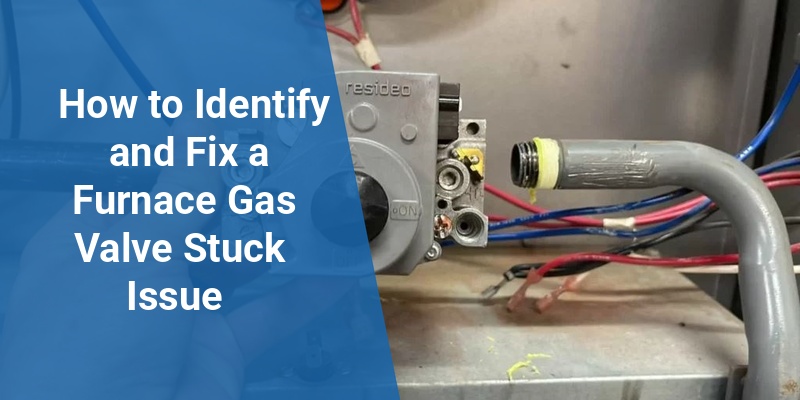When a furnace gas valve gets stuck, it can lead to heating problems or safety risks. Understanding why a gas valve becomes stuck and how to diagnose and repair this issue is crucial for homeowners. Addressing a stuck furnace gas valve promptly can restore home comfort and ensure safe furnace operation.
| Symptom | Possible Cause | Recommended Action |
|---|---|---|
| Furnace Not Igniting | Gas valve stuck closed | Inspect and reset or replace valve |
| Continuous Heating | Gas valve stuck open | Shut off gas and repair valve |
| Hissing or Gas Odor | Valve leak or partial opening | Immediate gas shutoff and professional service |
| Intermittent Furnace Operation | Malfunctioning valve solenoid | Test and replace solenoid coil |
How Furnace Gas Valves Work
A furnace gas valve controls the flow of natural gas or propane to the burner assembly. It opens to allow gas for ignition and closes to stop the flow when heating is complete. Typically, the valve is electronically or mechanically controlled by the thermostat system.
Reliable valve operation is essential for safe furnace ignition and efficient heating. Problems arise when the valve fails to open or close due to mechanical issues, worn parts, or electrical malfunctions.
Common Causes of a Stuck Furnace Gas Valve
- Mechanical Obstruction: Dirt, debris, or corrosion inside the valve can block movement.
- Valve Solenoid Failure: The solenoid coil that triggers the valve may be burned out or electrically faulty.
- Thermostat or Control Board Problems: Faulty signals may cause the valve to remain closed or open.
- Wear and Tear: Old valves with worn seals and moving parts may stick.
- Improper Installation or Gas Pressure: Incorrect gas pressure or installation errors can impact valve function.
Symptoms Indicating a Gas Valve May Be Stuck
Recognizing signs of a stuck gas valve can prevent furnace damage or dangerous gas leaks.
- Furnace fails to ignite: The valve may be stuck closed, preventing gas flow.
- Heater runs continuously: The valve could be stuck open, delivering gas nonstop.
- Unusual noises: Hissing or clicking sounds near the valve may signal mechanical issues.
- Gas odor: A stuck or leaking valve may emit a noticeable smell of natural gas.
- Intermittent operation: Furnace cycles erratically due to inconsistent valve behavior.
Diagnosing a Furnace Gas Valve Problem Safely
Only qualified professionals should conduct gas valve inspections due to safety risks. However, some diagnostic steps can be performed cautiously by homeowners:
- Check the thermostat settings: Ensure proper temperature programming and that the thermostat calls for heat.
- Power supply verification: Confirm the furnace has electrical power, and fuses or breakers are intact.
- Listen for the valve click: When the furnace starts, a click indicates the solenoid energizing.
- Observe furnace ignition behavior: Repeated ignition attempts or failure to light can suggest valve issues.
- Visual inspection: Look for signs of dirt, corrosion, or damage around the gas valve.
Steps to Fix a Furnace Gas Valve That Is Stuck
Addressing a stuck furnace gas valve involves thorough troubleshooting and repair or replacement where needed.
Cleaning and Lubrication
Dirt and debris accumulation can cause sticking. Carefully cleaning accessible parts with valve-safe solvents and lubricants may restore movement. Never apply flammable fluids or spray near gas connections.
Call 888-906-9139 for Free Local HVAC Quotes – No Obligation, Just Savings!
Checking and Replacing the Solenoid Coil
If the solenoid does not energize properly, the valve will stay stuck closed or open. Testing coil resistance with a multimeter can identify faults. Replacing the coil often resolves electrical valve failures.
Testing Gas Pressure
Incorrect gas pressure might cause valve malfunction. A licensed technician should measure and adjust the gas line pressure per manufacturer specifications, ensuring safe operation.
Valve Replacement
When cleaning or coil replacement does not solve the problem, valve replacement is the safest option. Furnaces require valves that match their specifications for pressure and fuel type.
Safety Tips When Dealing With Furnace Gas Valve Issues
- Turn off gas supply: Always shut off the gas before inspecting or repairing the furnace gas valve.
- Ventilate the area: Open windows and doors if a gas odor is detected to prevent buildup.
- Do not attempt complex repairs: Gas valves are safety devices; improper handling can cause leaks or explosions.
- Hire qualified HVAC technicians: Certified professionals have the training and tools to diagnose and fix gas valve problems safely.
- Install gas leak detectors: These devices provide early warnings of leaks and enhance home safety.
Preventive Maintenance to Avoid Gas Valve Problems
Routine furnace maintenance reduces the likelihood of gas valve sticking or failure.
- Annual professional inspections: HVAC specialists can check valves, solenoids, and controls during preventive maintenance.
- Keep the furnace clean: Remove dust and debris around the valve and burner areas.
- Monitor thermostat function: Efficient control prevents excessive cycling that can wear valves.
- Replace old valves proactively: Aging valves may develop leaks or stickiness requiring early replacement.
When to Call a Professional HVAC Technician
If the furnace shows any sign of gas valve malfunction, such as failure to ignite, continuous heating, or gas smell, contact a licensed HVAC technician immediately. Professionals can safely diagnose, repair, or replace the gas valve, ensuring compliance with safety codes and manufacturer guidelines.
